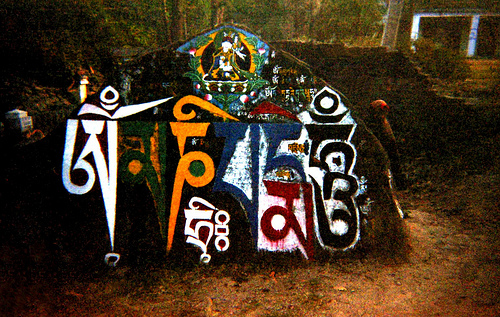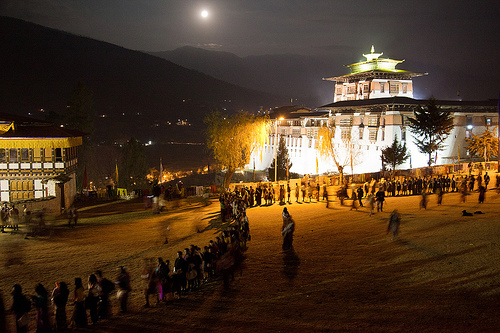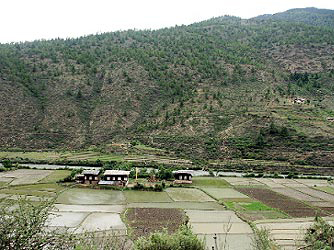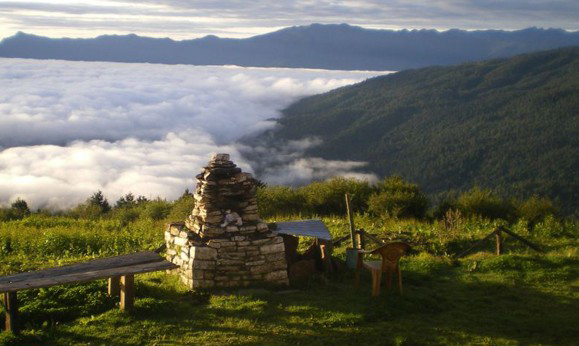
[ Thimphu Festival Tour | Thangbi Mani Festival Tour | Jambay Lhakhang Drup Tsechu Festival Tour | Black Crane Festival Phobjikha Tour | Punakha Domchey Festival Eight Nights Tour | Punakha Domchey Festival Ten Nights Tour | Chorten Kora Tsechu (arrive Paro, Depart Paro) | Chorten Kora Tsechu (arrive Paro, exit India) | Chorten Kora Tsechu (arrive India, exit Paro) | Gom Kora Tsechu (enter Paro, exit Paro) | Gom Kora Tsechu (enter Paro, exit India) | Gom Kora Tsechu (enter India, exit Paro) | Paro Tsechu Festival Tour | Paro Tsechu Festival 7 Dzongkhags Tour | Paro Tsechu Festival Tour with Druk Path Trek | Ura Yakchoe Festival Tour ]
Paro Tsechu Festival Tour
- 6 Nights 7 Days
- Western Bhutan
Dzongkhags covered: Paro & ThimphuDuration: 6
Nights 7 Days.
Trip Grade: Easy.
Itinerary Outline:
Day 1: Arrival in Paro (2280 m.)
Day 2: Full day at the Paro Tshechu Festival
Day 3: Paro- Hike to Taktsang, the Tigers Lair
Day 4: Paro to Thimphu- Sightseeing Thimphu
Day 5: Thimphu- Phajoding
Day 6: Thimphu to Paro
Day 7: Paro Departure in the morning
Paro Tsechu:
Paro Tsechu: Tsechu or the religious festivals are usually the main tourist attractions for visitors. The Thimphu & Paro Festivals account for over 50 percent of the total arrivals; and certainly Paro Tsechu is the most popular one with its unique unfurling of the world’s biggest Thangka or Thongdrel ceremony. The pageantry is a unique experience like nothing you may have ever seen before. The festival commemorates deeds of the Great Saint Guru Rinpoche which are performed in the form of masked dances. The local folk attend these festivals to build merit. It is also a festive time for the locals who come dressed-up in their finest attire and dresses full of colour to socialise and make merry. This is not an event organised for tourists- it is an event that has been happening for centuries…”You may get the attention of the Atsara (clown), but the people won’t stare at you like elsewhere”.
Detailed Itinerary:
Day 1: Arrival in Paro (2280 m)
 During
your flight to Paro, you will experience awe-inspiring views of the Himalayan
Peaks including sacred Jhomolhari and Jichu Drakey in Bhutan. On arrival
at Paro International Airport you will be received by our representative.
Visit Tag (pronounced 'Taa') Dzong,
built in the 17th century as a watch tower for Paro Rinpung Dzong. Tag
Dzong was later converted into the National Museum in 1967, and is filled
with antique thangkha paintings, textiles, weapons and armour. Also visit
the Rinpung Dzong, built in the 17th century to defend the valley against
Tibetan invaders. It is now used as an administrative centre and home
of the monastic community here. Kyichu Lhakhang, the oldest monastery
of the Kingdom is another place of interest (above- painted on rock at
Kyichu Lhakhang- Om Mani Padme Hum. Buddhists believe that saying this
mantra (prayer), Om Mani Padme Hum- pronounced 'Ohm Maaney Peymey Hoon',
out loud or silently to oneself, invokes the powerful benevolent attention
and blessings of Chenrezig, the Embodiment of Compassion. Viewing the
written form of the mantra is said to have the same effect - thus, it
is often carved or painted into stones, like the one pictured above, and
placed where people can see them.)
During
your flight to Paro, you will experience awe-inspiring views of the Himalayan
Peaks including sacred Jhomolhari and Jichu Drakey in Bhutan. On arrival
at Paro International Airport you will be received by our representative.
Visit Tag (pronounced 'Taa') Dzong,
built in the 17th century as a watch tower for Paro Rinpung Dzong. Tag
Dzong was later converted into the National Museum in 1967, and is filled
with antique thangkha paintings, textiles, weapons and armour. Also visit
the Rinpung Dzong, built in the 17th century to defend the valley against
Tibetan invaders. It is now used as an administrative centre and home
of the monastic community here. Kyichu Lhakhang, the oldest monastery
of the Kingdom is another place of interest (above- painted on rock at
Kyichu Lhakhang- Om Mani Padme Hum. Buddhists believe that saying this
mantra (prayer), Om Mani Padme Hum- pronounced 'Ohm Maaney Peymey Hoon',
out loud or silently to oneself, invokes the powerful benevolent attention
and blessings of Chenrezig, the Embodiment of Compassion. Viewing the
written form of the mantra is said to have the same effect - thus, it
is often carved or painted into stones, like the one pictured above, and
placed where people can see them.)
 Day
2: Full day at the Paro Tshechu Festival
Day
2: Full day at the Paro Tshechu Festival
To briefly decribe, the Paro Tsechu in spring is a major attraction in Paro district. People come from neighbouring districts to participate in the festivity. On the final day, the best time to go is early in the morning as the monks of the Paro Dzong prepare to display a giant appliqué thangkha, the Guru Throngdel, inside the Dzong. The dances all have different meanings/reasons: For instance there is the Dance of the Lord of Death (Bodhisattva Manjusri– representing the Wisdom of all Buddhas ) and his Consort– takes on the appearance of the terrifying Lord of Death (Shinje). His wrathful buffalo face guards the four continents. There’s also the Dance of the Lords of the Cremation Grounds (Durdag) and Religious song (Chhoeshay) commemorating the opening of the gateway to the pilgrimage site of Tsari in eastern Tibet by the founder of the Drukpa School of Buddhism, Tsangpa Jarey. Other dances include Dance of the Black Hats with Drums (Shanag Nga Cham) where the sound of the drum represents religion itself, Dance of the Three Kinds of Ging with Sticks (Gingsum), Dance of the Three Kinds of Ging with Drums (Driging), Dance of the Stag and the Hounds (Shawa Shachi), Dance of the Terrifying Deities (Tungam), Dance of the Heroes with Six kinds of Ornaments (Guan Drug Pawo), Dance of the Noblemen and Ladies (Pholeg Moleg), Dance of the Four Stags (Sha Tsam), Dance of the Judgement of the Dead (Raksha Mangcham), Dance of the Drums from Dramitse (Dramitse Nga Cham), Dance of the Heroes (Pacham), Dance of the Ging and Tsholingand the Dance of the Sixteen Fairies. (Above picture shows people queuing for blessings outside the Rinpung Dzong in the wee hours of the morning).
The focal point of the Tsechus are the sacred Cham Dances, which have been banned in our neighbouring Tibetan by the Chinese government. These costumed, masked dances typically are moral vignettes, or based on incidents from the life of the 9th century Nyingmapa teacher Padmasambhava (also known as Guru Rinpoche) and other saints.
Day Three: Paro- Hike to Taktsang, the Tigers Lair
Hike to the famous Tiger’s Lair ‘Taktsang Lhakhang’. Clinging to a black rock face 900 metres, the Tiger’s Lair above the valley floor nestles Taktsang Lhakhang, one of the holiest and most beautiful sites of Bhutan. Taktsang, the Tiger's Lair, acquires its name from the legend of its founding, when in the 8th Century Guru Rinpoche, widely revered as the second Buddha, arrived from Tibet flying across the mountains on the back of a tigress. He meditated at the site for three months, from where he used the religious cycle of the Kagye to subjugate the Eight Categories of Evil Spirits, and thus converted the region to Buddhism. The hike to the Monastery is a gradual climb through the quiet approach path winds through lush meadow, oak and rhododendron forests, past quaint hamlets, fluttering prayer flags and rotating prayer wheels. The hike takes you about 4-5 hours from the car park. Lunch at Taktsang teahouse with its spectacular view of the famous monastery. Horses/mules are available for those preferring not to walk. Overnight in Paro. Total Hiking Time: About 3 Hours.
Day Four: Paro to Thimphu- Sightseeing Thimphu
 We
head out through the relaxing countryside of terraced rice fields
(left) interspersed with rhododendron and pine forests as we
make an hour’s drive to Thimphu, the tiny capital at 7,600 feet
(3216 metres above sea level). En route, we see our first examples of
Bhutan’s remarkable traditional architecture, one of the country’s
unique cultural treasures. Even the most remote village farmhouses are
hand-crafted using the same ancient methods used to create Bhutan’s
religious fortresses called "Dzongs". Afternoon, we visit the
Tashichhodzong. This ‘Fortress of the Glorious Religion’ houses
the Throne Room of His Majesty the (Fifth) King, Jigme Khesar Namgyel
Wangchuck, the main Secretariat Building and the Central Monk Body. Its
courtyard is open to visitors during the off-office hours (on weekends
after 4 pm (winter), 5pm (summer). Overnight at your Three Star Hotel.
We
head out through the relaxing countryside of terraced rice fields
(left) interspersed with rhododendron and pine forests as we
make an hour’s drive to Thimphu, the tiny capital at 7,600 feet
(3216 metres above sea level). En route, we see our first examples of
Bhutan’s remarkable traditional architecture, one of the country’s
unique cultural treasures. Even the most remote village farmhouses are
hand-crafted using the same ancient methods used to create Bhutan’s
religious fortresses called "Dzongs". Afternoon, we visit the
Tashichhodzong. This ‘Fortress of the Glorious Religion’ houses
the Throne Room of His Majesty the (Fifth) King, Jigme Khesar Namgyel
Wangchuck, the main Secretariat Building and the Central Monk Body. Its
courtyard is open to visitors during the off-office hours (on weekends
after 4 pm (winter), 5pm (summer). Overnight at your Three Star Hotel.
About Thimphu:
Thimphu was a wooded farming valley until 1961, when it became Bhutan's
official national capital (previously it was Punakha). Even today, it
still only has minimal roads and no traffic lights. The massive Tashichhodzong,
about 700 years old, was carefully revamped in the 1960s by the late Third
King, Jigme Dorji Wangchuck, to house the royal and main government offices.
It is also the summer residence of the Je Khenpo, Bhutan’s Chief
Abbot (equal in rank with the King). Even the most remote village farmhouses
are hand-crafted using the same ancient methods used to create Bhutan’s
religious Dzongs (fortresses). Thimphu is home to the Bhutanese Royal
Family, the Royal Government and to several foreign missions and development
projects. Bhutan’s only golf course, a nine-hole circuit, is situated
next to the magnificent Tashichhodzong. The Third King, Jigme Dorji Wangchuck
was the main architect of modern Bhutan. He died in 1972 and was succeeded
by his son, His Majesty the (Fourth) King, Jigme Singye Wangchuck, who
was 17 years old at the time.
 Day
Five: Thimphu- Phajoding
Day
Five: Thimphu- Phajoding
Day excursion (2-3 hours hike or horses/mules)
to the 13th century Phadoding Monastery at the top of the hill overlooking
Thimphu. Phajoding Monastery (at right- view from Phajoding of
Thimphu wrapped in cotton like clouds) is a 3-hour hike from
the nearest road and is located above Bhutan’s capital, Thimphu.
It was once one of the richest and most decorated monasteries in the country.
UNESCO’s World Monument Fund has now listed it as one of the five
endangered cultural monuments that needs the most help in the world. Besides
being home to many very sacred Buddhist artifacts it is also a refuge
for underprivileged boys. Phajoding, which is considered to be one of
the most sacred sites in Bhutan, takes its name from the Saint Phajo Drugom
Zhigpo, who meditated there in the 13th century. The monastery itself
is an open complex that comprises many holy buildings and relics and a
State monastic school that currently houses 35 monks. Monastic schools
like Phajoding are places of refuge, education and cultural preservation
that also provide social services and moral support to the Bhutanese community.
Dinner and overnight in Thimphu.
Day Six: Thimphu to Paro
Return to Paro and the festival. Farewell
dinner and overnight at hotel.
Day Seven: Paro Departure in the morning
We say goodbye and hope to see you again.
| |
BACK TO FESTIVAL TOURS MAIN PAGE |